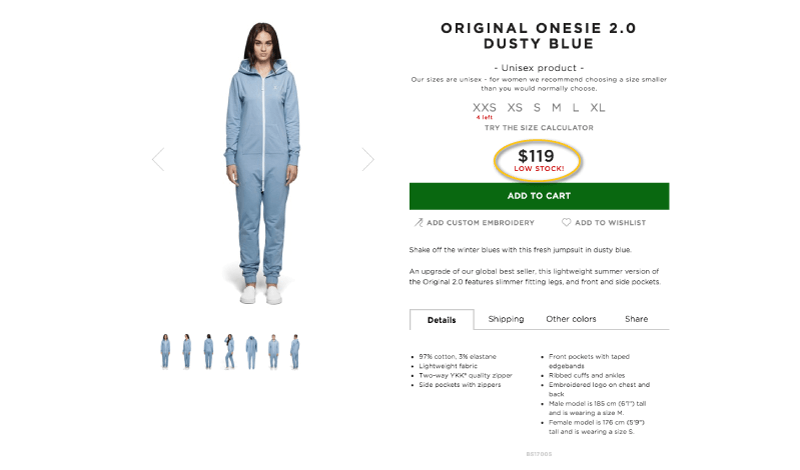
eCommerce psychology is the new way to think about how your online shoppers are buying. Retail giants have been using human psychology to sell more for years, but not much has been written on using the same tactics in ecommerce.
eCommerce is a completely different world than retail but many of the psychological tricks still apply, you just need to know how to apply them to the online world. In this post I will go over how to use the popular persuasion principles in ecommerce. Before I begin remember that that these tactics should be used to help your customers not for manipulation purposes.
Is Your Site Persuasive?
Why are sales people so dang convincing? Through reading or trial and error they have come across tips and tricks to get our minds working in their favor. They have become “persuasive”!
They use our mental shortcuts to make products, timelines, and deals convincing. Call it scumbag or good salesmanship, but it is effective. The gospel on persuasion is Dr. Robert Cialdini’s book titled “Influence.” His book explains how to use the six principles of persuasion to get people to say “YES” or to “BUY.”

The only problem with “Influence” is that it was published in 1985 - 10 years before Amazon and eBay were founded and way before ecommerce as we know it today. This makes the book slightly dated to use for ecommerce psychology. Don’t worry though, I have taken all the teachings and adapted them to the ecommerce world.
Here is how to apply the 6 persuasion principles to your ecommerce store complete with tips to get you started. You can also click on each principle to get tips and tricks specific to that principle.
eCommerce Psychology 101
Consider this a brief introductory lesson to using ecommerce psychology! After reading this guide you will have a good understanding on how to infuse psychology tricks into your store. But if you want more detail you can go into each principles individual lesson.
Before we get to far into our lessons here is a quick video explanation of the six persuasion principles courtesy of influenceatwork.
Now we can get into each principle in more detail for ecommerce.

The reciprocity principle is based on the idea of if you scratch my back i’ll scratch yours. If you provide something of value to your shoppers they will provide you with something of value in return (a sale).
Now you may ask yourself how am I supposed to give something to my shoppers when I don’t know anything about them until they enter information at the time of purchase. Great question and while there are tons of things you can do post purchase the best ecommerce reciprocity technique is pre-sale.
Content marketing is one of my favorite reciprocity techniques for ecommerce psychology, followed closely by points programs! A store can help answer a question or problem and a shopper will reward them with their business. Take this question I had the other week.

I had a question, I asked Google, I got an answer from a company selling goods I am clearly interested in. Providing me with the information I was after was a great way to use the reciprocity principle. I recommend a content marketing strategy for anyone in the ecommerce industry.
Some Other Reciprocity Tactics for eCommerce Include:
- Free gifts
- Shipping inserts
- Points programs
- See more

We have all been influenced by this principle whether we were aware of it or not. This principle states that we are more likely to be persuaded by people we like. But what makes us like someone?
According to Cialdini we like those who are attractive, similar, and pay us compliments. This is why a car salesman is always well dressed and continually asks you about your interests. They are looking for a way to seem similar to you. If they become like you then they can more easily influence your decision.
But obviously this tactic has no use in ecommerce psychology where our customer’s identity is hidden behind a screen possibly miles away. Wrong! There are a ton of ways to make your ecommerce site more likable, but my favorite is what I call humanization.
This is the act of making your website seem more human to your visitors like in the example from Lush above. When you show your potential shoppers the personality of you and your store they are more likely to identify it as similar to them. This causes them to “like” your store and makes you much more pleasant to do business with.
Some Other Liking Principle Tactics Include:
- Providing an amazing customer experience
- Ads that create familiarity
- See more

The scarcity principle revolves around using language that implies an item is rare or hard to get. I am sure you have seen this tactic used countless times before at all of your favorite retail locations.
This is one of the few principles that can be implemented in ecommerce the same way it was historically used in retail. The easiest way to get this psychological trick working on your site is to draw attention to the availability of a resource.
This resource can be time (the item or offer is only going to be around for a set time frame) or it can be stock (the item is only in limited quantities). No matter what scarce resource you use the best way to create it in ecommerce is with counters.
A counter or countdown can be used to show stock like in this example from Onepiece.

Or to show time remaining like in this example from ASOS.

eCommerce sites allow you to display these counters in real time and nothing is more nerve racking than watching something slip away in real time. These counters are fantastic especially if shown on the checkout page where they can have the largest impact on checkout conversion.
Some Other Scarcity Principle Tactics Include:
- Limited edition items
- Seasonal offerings
- The vault technique
- See more

If a man in a police uniform asked you to do something you would likely comply with no questions asked. But what if that was just a regular old civilian like you and I in an officer’s uniform? As humans we naturally drawn to things or people we view as credible or authoritative. This provides some interesting opportunities in ecommerce psychology!
When we are looking for ways to establish credibility we often create shortcuts to quickly establish if something is credible or not. These could be: uniforms, badges, 5 star reviews or really anything. The easiest ways to use authority on your ecommerce site plays on these shortcuts.

Expert reviews are an easy way for your ecommerce site to establish its credibility! Reviews alone are great but when they come from a source that is viewed as an expert (authority) in your field they become so much more valuable. The example above illustrates this perfectly, Herbalife uses a Doctor to showcase their nutrition products.
When we don’t know much about a product we look to others who should know better than us for advice. You can make that search easy by showing expert reviews right on your site. It is also important to note that an expert doesn’t have to be a doctor just look at Aaron or alpha m who is considered an expert in men’s fashion.
Some Other Authority Principle Tactics Include:
- Content marketing
- Credible imagery
- Endorsements
- See more

If I were to tell you that you looked like someone who cares about the environment would you be more likely to purchase eco-friendly detergent? Well the research says you would!
The consistency principle states that we are more likely to perform an action when it aligns with what we have done in the past. We like to keep a consistent public image of ourselves, so if people think we like the environment we better stay consistent with that belief and by eco-friendly detergent.

Example and shameless plug using consistency
Savvy ecommerce owners can get the consistency principle working for them on their store by getting shoppers to make public statements. Like I said before we like to keep consistent with the public’s image of us and a public statement becomes part of our identity.
One way to do this is to get shoppers to share a purchase over social media. This gets a customer to make a public statement that they shop at your store and makes them much more likely to shop with you again. That is the reason Amazon always asks you to share what you bought.

Unfortunately many people (including myself) skip sharing because it is not mutually beneficial. What do I get for sharing your store over social media?
One of the best ways to motivate customers to perform actions on your site is with a loyalty program. You can give a customer points when they share your store, refer a friend, register for an account and more.
Some Other Consistency Principle Tactics Include:
- Referral programs
- Public statements
- Social sharing
- See more

You probably know the consensus principle by its other name, social proof. This principle is the idea that we are more likely to be persuaded when we know that others have already done it. This becomes more effective when we the others as similar to us in some way.
This principle is why bars and clubs purposely create lineups out front. It makes you think that if that many people all want to get in then the place must be really good. However, you cannot easily let someone see how many shoppers are on an ecommerce site, but there are some other ways to use social proof in ecommerce.
Using social proof in ecommerce is actually fairly easy, and there are a ton of ways to use it. My favorite social proof tactic is using it to promote cross sells.

Many times when a shopper is looking to buy something they are not an expert on everything that goes along with that initial purchase. This is where cross sells become an amazing opportunity. You can recommend products that compliment a shopper’s initial item.
In the example above I was looking at a playstation and was then shown items frequently bought together. But the more powerful suggestion is what customers like me also bought. In the example above I am shown what others who bought a playstation also bought. This makes those other customers similar to me and creates an easy way to assess what else I need.
The key to social proof in ecommerce psychology is to make others appear as similar to your shopper as possible. This will make the messaging super effective.
Some Other Consensus Principle Tactics Include:
- Reviews
- Social sharing
- User submitted content
- See more
Using eCommerce Psychology
You now know the basics of using ecommerce psychology to boost your online sales! You do not need to use every principle presented but the more that you incorporate the stronger your store’s persuasion becomes. Remember that you can also click on each individual principle for a detailed lesson on each.
Now what principle should I use to get you to share this article?
- You seem like an ecommerce expert! I think your followers would benefit from you sharing this article. (consistency)
- Share this article and mention @alexmcea and I will retweet and follow! (reciprocity)
- Smile.io articles are read by over 15,000 readers just like you, so you know this article is worth a share! (consensus)
Thanks for reading, you are amazing!








